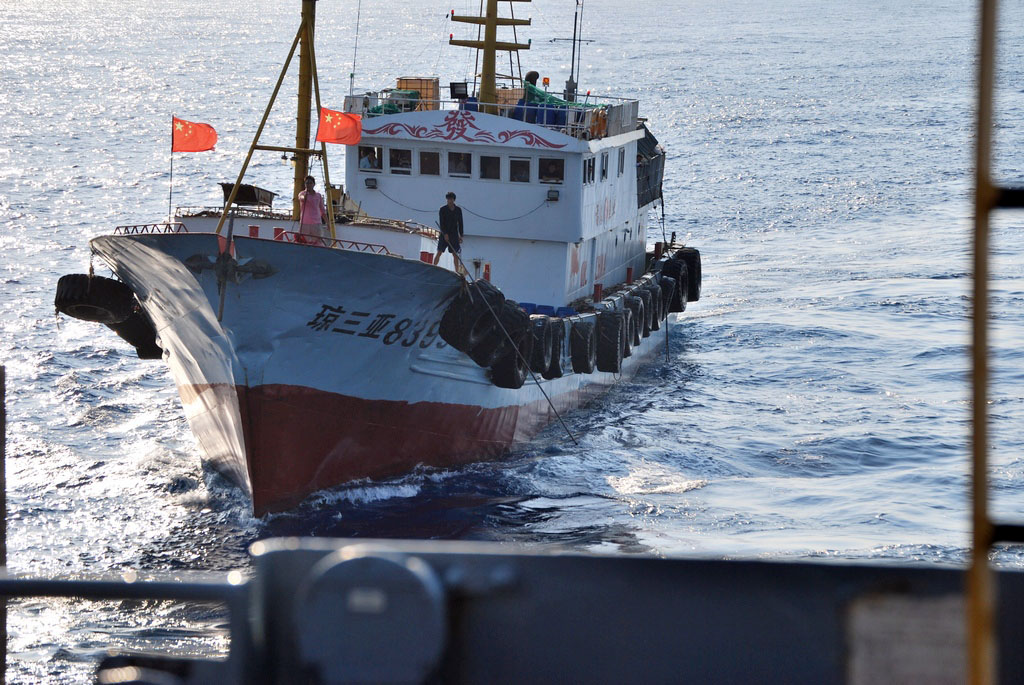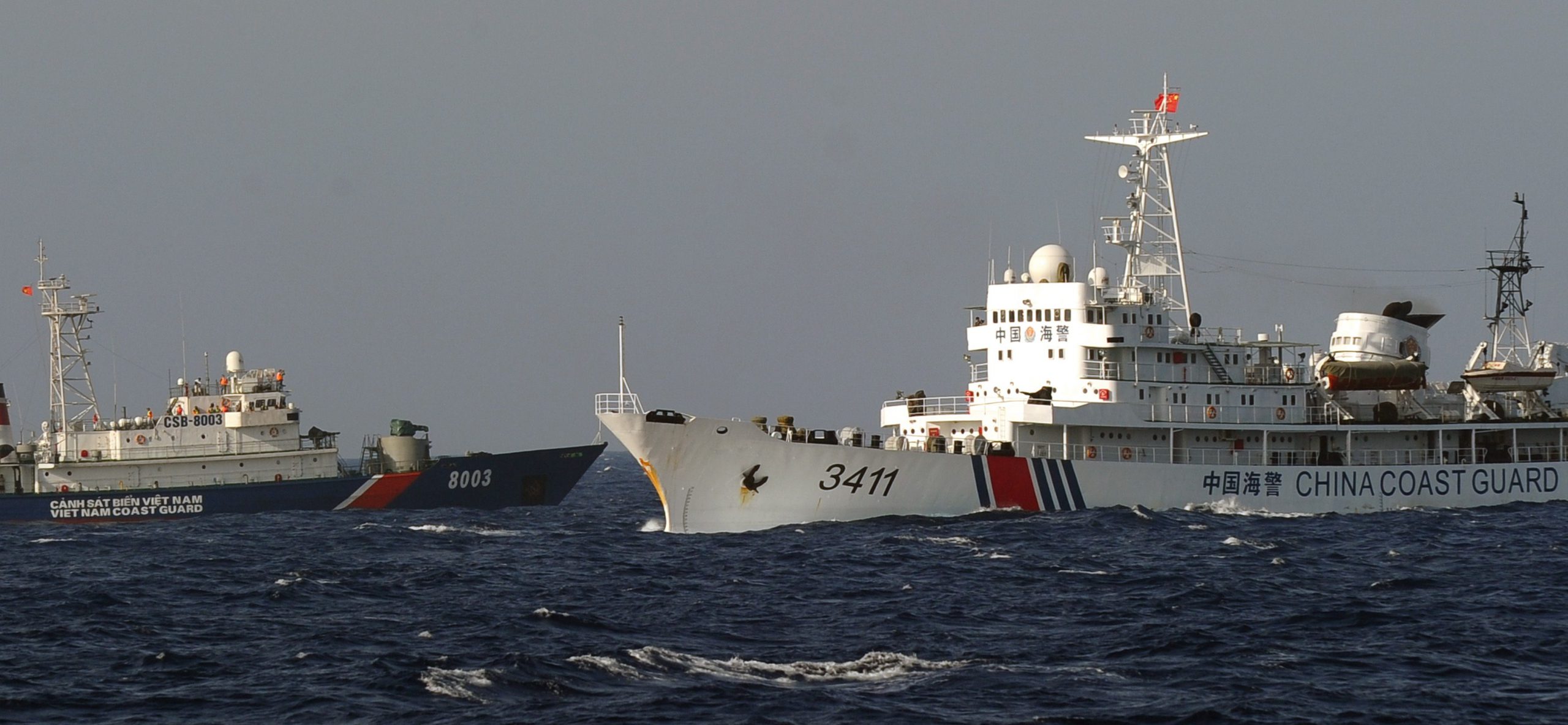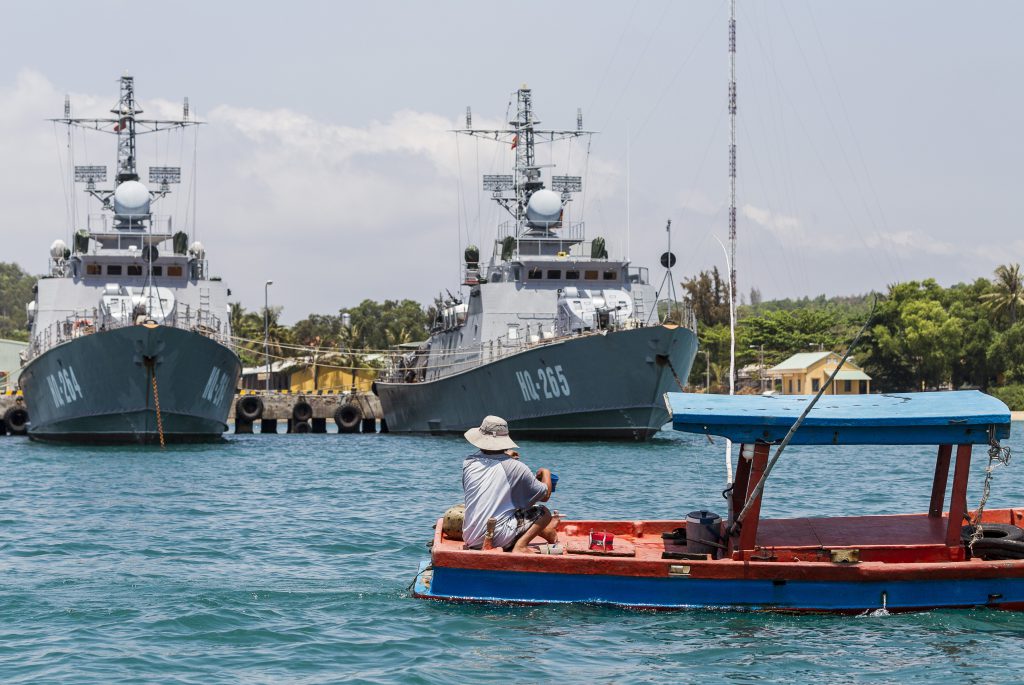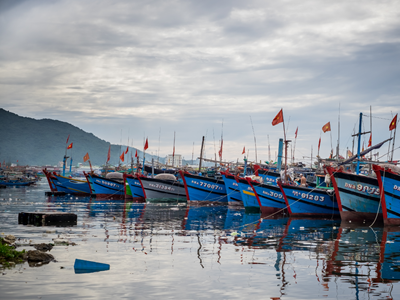Maritime Militias in the South China Sea
Nguyen Hong Thao and Ton Nu Thanh Binh conduct a comparative analysis of the functions of both China’s and Vietnam’s maritime militias. The first section of the essay will consider the role that each country’s militia plays in maritime law enforcement. The essay will then assess the legality of the use of these forces in the South China Sea.
In early April 2019, the Philippines protested the presence of more than two hundred Chinese vessels that since January had blocked Sandy Cay, a disputed area near a Philippine-occupied island called Pagasa in the Spratly Islands. At the same time, Vietnam lodged an official protest against Chinese maritime surveillance vessels that chased and fired at a Vietnamese fishing boat in the disputed waters around the Paracel Islands. These incidents once again have raised questions about the legality of China’s use of its maritime militia to enforce its claims in the South China Sea. Vietnam has built its own militia to respond to attacks and intimidation by “strange vessels” in Vietnamese-claimed waters.[1]
This essay will conduct a comparative analysis of the functions of both China’s and Vietnam’s maritime militias. The first section will consider the role that each country’s militia plays in maritime law enforcement. The essay will then assess the legality of the use of these forces in the South China Sea.
THE FUNCTIONS OF THE CHINESE AND VIETNAMESE MILITIAS
China has the largest coast guard in the world, with a total tonnage of 190,000 registered in 2016, roughly three times the combined tonnage of Indonesia, Malaysia, Vietnam, and the Philippines coast guards. Nonetheless, China still is developing its maritime militia as a part of the “people’s war” doctrine to support its coast guard.
The Chinese maritime militia (CMM) is built as a subset of China’s national militia. The 2013 Chinese defense white paper provides that the militia is a supportive and backup force for the People’s Liberation Army (PLA). The CMM receives military training from the PLA Navy and participates in drills with the navy and coast guard. Recently, special units have been established such as service support detachments, specialized naval militia detachments, or the People’s Armed Forces Maritime Militia. The People’s Armed Forces Departments coordinate the activities of the CMM with the PLA.
Under Article 36 of the China Military Service Law of 1984, revised in 1998, the CMM has the functions “to undertake the duties related to preparations against war, defend the frontiers and maintain public order; and be always ready to join the armed forces to take part in war, resist aggression and defend the motherland.” According to Article 36, the CMM is only a military auxiliary and not part of Chinese maritime law enforcement. However, with the function to “defend the frontiers,” it is employed as an advance guard to reinforce the nine-dash line claim in the South China Sea in order to avoid accusations of use or threats of the use of force. This is the Chinese tactic of “salami slicing” or coercive gradualism to gain advantages over smaller states. In this strategy, the CMM serves as the first slice, the China Coast Guard as the second slice, and the PLA Navy as the final one. The CMM uses fishing boats not for fishing but, together with the China Coast Guard, for intimidating regional countries, encroaching on spots under the control of other states, and harassing foreign fishermen from their claimed traditional fishing grounds. If countries then employ their coast guards or navies to defend their own fishermen, the PLA Navy would appear to turn what was once a non-disputed area under the traditional view of other countries into a disputed one, as happened in Scarborough Shoal.
The salami slicing strategy was employed in the 1962 and 1974 conflicts over the Paracel Island, as well as in the 1995 Mischief Reef and 2012 Scarborough Shoal incidents. In the latter standoff, the CMM was used to challenge foreign coast guards and even navies. This was also the case in the 2014 standoff with the Haiyang Shiyou (HYSY) 981 oil rig. Other incidents involving the CMM include the harassment of the USNS Impeccable in 2009, the maneuvers around the USS Lassen in 2015, the cutting of submarine cables of the Vietnamese seismic survey ships Binh Minh 02 and Viking II in 2011 and 2013, and the blockade of Second Thomas Shoal in 2014 and Pagasa island (controlled by the Philippines) in 2019. The CMM has also been involved in illegal fishing in Indonesian waters, helped enforce China’s unilateral fishing ban in parts of the South China Sea, and supported land-reclamation activities.[2]

A March 8, 2009 photo taken on board the ocean surveillance ship USNS Impeccable as it was harassed by an apparent Chinese maritime militia vessel in international waters 75 miles south of Hainan Island. (U.S. Navy Photo)
In 1995, China introduced a special policy on fuel subsidies and shipbuilding funding to encourage fishing at sea.[3] Under this policy, the number of Chinese fishing vessels has increased dramatically from merely 50,000 in 1979 to over 700,000 in 2014, 200,000 of which are offshore fishing vessels. Hundreds of these boats are equipped with steel-reinforced hulls and water cannons for ramming and sinking foreign fishing boats. Sansha City’s maritime militia, established in 2013, has five special tasks: (1) defending sovereignty, (2) conducting intelligence, surveillance, and reconnaissance, (3) coordinating with maritime law enforcement, (4) taking part in search and rescue, and (5) supporting military activities. They are “trained to participate in a variety of missions, including law enforcement.”[4]
The U.S. Department of Defense has observed that a larger CMM that undertakes “low-intensity coercion activities” will “afford China the capability to patrol more robustly its claims in the East China Sea and the South China Sea.”[5] Per its legally defined functions, the CMM is not a force of maritime law enforcement. However, given its aggressive behavior in real incidents and its operation under the direction of the PLA, the CMM is in practice a third sea force that supports China’s goal of gaining control over the whole South China Sea through a policy of coercive gradualism.
The Vietnam Maritime Militia (VMM) operates under the 2009 Law on Militia and Self-Defense Force. Article 3 of the law stipulates that “militia and self-defense force are mass armed forces not detached from production and work and constitute a part of the people’s armed forces of the Socialist Republic of Vietnam.” Among its responsibilities are to “protect the Party, the administration, the lives and property of people and property of the State, act as core forces together with the entire people to fight enemies in their localities and workplaces when a war breaks out.” Unlike the CMM, the VMM is not professional or permanent. However, in response to new situations in the South China Sea, the Law on Militia and Self-Defense Force is expected to be modified in 2019 to allow the organization of a permanent militia and self-defense force.
In peacetime, the VMM helps the Vietnam Coast Guard, Border Defense Force, and Fishery Resource Surveillance in collecting information, conducting search and rescue activities, protecting the country against piracy and other maritime crimes. In wartime or conflicts, the VMM coordinates with the Vietnam Border Defense Force, People’s Navy, Coast Guard, People’s Police, and other forces in defending national security, sovereignty, sovereign rights, and jurisdiction over Vietnamese waters. In the HYSY 981 oil rig incident, the VMM and Vietnam Fishery Resource Surveillance were deployed to deal with the CMM, the front-line force backed by the China Coast Guard and PLA Navy. Although some Vietnamese fishing boats were rammed and sunk by the CMM and China Coast Guard, the VMM demonstrated substantial restraint in challenging the activities of HYSY 981 and managed to keep the skirmish under control while avoiding any pretext for the incident to escalate into a full-blown conflict.

A Vietnamese Coast Guard ship is challenged by a China Coast Guard ship near the site of a Chinese oil rig (background, right) in disputed South China Sea waters off Vietnam’s central coast, May 14, 2014. (Hoang Dinh Nam/AFP/Getty Images)
The VMM is equipped with light arms to perform its self-defense function. Although inferior to the CMM in terms of size and equipment, the VMM fulfills its role in countering China’s use of the CMM as a first core provocative force in the South China Sea. The development of the VMM is essential for Vietnam’s economic development and self-defense by preventing and mitigating the risk of armed conflicts at sea. Yet, whereas the VMM is a paramilitary force with functions limited to self-defense, the CMM is characterized by some U.S. observers as a military force — often in disguise. Or to use the words of the PLA Daily, “Putting on camouflage, they qualify as soldiers; taking off the camouflage, they become law-abiding fishermen.”
THE LEGAL CONSTRAINTS ON THE USE OF THE COAST GUARDS AND MARITIME MILITIAS
The use of coast guards and maritime militias must conform to international law. Setting aside the issue of the legality of Chinese-claimed maritime zones, the China Coast Guard and CMM have violated the International Regulations for Preventing Collisions at Sea (enacted in 1972) by ramming and firing water cannons to sink other boats and vessels, cutting submarine cables, and obstructing the lawful navigation of other vessels.
The regulation on the use of fishing boats in conflicts reflects a gap in international law. A fundamental principle of the law governing armed conflicts is that parties to a conflict must distinguish between civilian and military objects.[6] Under the law of naval warfare, merchant vessels mobilized to assist enemy forces can be considered as military objects and attacked by warships. Can an auxiliary naval force be involved in the use of force or threaten to use force against legitimate fishing vessels in occupied isles? Is it possible that the enforcement functions undertaken by the CMM against Vietnam, the Philippines, and even Indonesia justify actions of individual or collective self-defense by these countries? This is a gray area of international law, and these questions remain unanswered.

A Vietnamese fisherman moves in the vicinity of a naval base with ships from the Vietnam Coast Guard and Navy in Phuc Quoc province, Vietnam, on March 13, 2014. (Le Quang Nhat/AFP/Getty Images)
The use of maritime militia raises another question of how to distinguish normal fishing vessels from military and auxiliary vessels. The former are protected by the law of armed conflict. In cases of conflict, maritime militia under the flag of fishing vessels that are involved in military actions can escape from sanctions from the regular naval forces of other countries, including U.S. naval ships. Even the United States has changed its attitude toward the role of the CMM. In January 1974, when China used fishing boats to provoke the South Vietnam Navy, U.S. intelligence accepted Beijing’s narrative that “Saigon’s military response to the move of Chinese fishermen into the Crescent [island] group” was the “key step in the escalation.” However, the U.S. Department of Defense expressed a different view in a 2018 report to Congress, which warned that “in the South China Sea, the People’s Armed Forces Maritime Militia…plays a major role in coercive activities to achieve China’s political goals without fighting; part of broader PRC military doctrine stating confrontational operations short of war can be an effective means of accomplishing political objectives.”[7]
RECOMMENDATIONS
The China Coast Guard and Vietnam Coast Guard have strengthened their cooperation in various areas, including joint patrols in the Tonkin Gulf, ship visits, search and rescue, and exchanges of young officers in accordance with a memorandum of understanding signed in 2016. China also has actively responded to Vietnam’s request for assistance in the search for and rescue of missing Vietnamese planes.
The same mechanism of cooperation should be set up between the CMM and the VMM for the purpose of maintaining peace, security, and order in the South China Sea. The first step is to conclude a joint fishing agreement in the South China Sea to avoid any conflict in competition for resources and create favorable conditions for fishing activities instead of naval functions. A joint fishery zone should be established beyond 200 nautical miles from the coasts of all claimant countries (China, the Philippines, Brunei, Malaysia, and Vietnam). A similar model can be found in China’s agreements on common fishery zones with both Japan and South Korea.[8] Some principles of joint fishing management in the common fishing zone of the Gulf of Tonkin can be applied. In addition, a joint committee on fisheries could be set up to conduct a survey and determine the allowable catch for fishing vessels operating in the region.
The second necessary measure is establishing a hotline between the CMM and the VMM to prevent a conflict. Both sides need to agree to respect the Code for Unplanned Encounters at Sea and inform each other of ships’ registration numbers and identification marks when carrying out government tasks. Each side must also appoint a competent point of contact—preferably from the Chinese People’s Armed Forces Departments and the Vietnam Militia and Self-Defense Force Department—who would be responsible for hotline and internal communication to settle conflicts as soon as possible.
Finally, the regulation of maritime militias should be included in the ongoing negotiation of a code of conduct in the South China Sea, given the challenges these forces pose and their profound impacts on the law of naval warfare. Such measures would help ensure that fishing vessels do not become involved in surreptitious law-enforcement activities, such as ramming ships, harassing foreign vessels, or participating in blockades of islets under the control of other countries.
Nguyen Hong Thao is an Associate Professor at the Mien Dong University of Technology in Vietnam.
Ton Nu Thanh Binh is a Teaching Assistant at the Diplomatic Academy of Vietnam.
Download a PDF version of this analysis piece here.
ENDNOTES
[1] The phrase “strange vessel” appeared in the Vietnamese media. See, for example, Anh Duy, “Tàu cá Quảng Ngãi bị tàu lạ đâm chìm trên biển” [Quang Ngai Fishing Vessel Sunk by Strange Vessel at Sea], VnExpress, August 7, 2018.
[2] See the interactive map on the Maritime Awareness Project website for further information about these incidents.
[3] Zhang Hongzhou, “Maritime Militia and Fishing Conflicts in the South China Sea,” S. Rajaratnam School of International Studies (RSIS), Policy Brief, March 2017, 54.
[4] U.S.-China Economic and Security Review Commission, 2017 Report to Congress (Washington, D.C., November 2017), 238.
[5] U.S. Department of Defense, Annual Report to Congress: Military and Security Developments Involving the People’s Republic of China 2016 (Washington, D.C., 2016), 69. See also Brian P. Klein, “How China’s ‘Maritime Militia’ Raises the Stakes for Clashes with the U.S. in the South China Sea,” South China Morning Post, May 10, 2019.
[6] Article 48 of the 1977 Additional Protocol I to the Geneva Convention of 1949 states: “In order to ensure respect for and protection of the civilian population and civilian objects, the Parties to the conflict shall at all times distinguish between…civilian objects and military objectives.” The full text is available at https://www.icrc.org/en/doc/assets/files/other/icrc_002_0321.pdf.
[7] U.S. Department of Defense, Annual Report to Congress: Military and Security Developments Involving the People’s Republic of China 2018 (Washington, D.C., 2018), 72.
[8] For a discussion of Article 7 of the Fishery Agreement between China and Japan and Article 7 of the Fishery Agreement between China and South Korea, see Joon-suk Kang, An International Regime for Fisheries in East Asia (Design Sesang, 2003), 74–89.
Banner image: Landscape of Thuan Phuoc port with fishing boats on August 30, 2016 in Danang, Vietnam.



